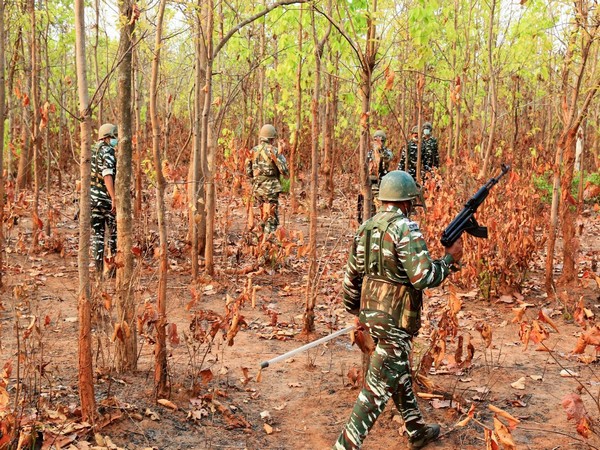In a historic counter-insurgency campaign, Indian security forces have achieved one of their most significant victories against Left Wing Extremism (LWE) along the Chhattisgarh-Telangana border. From April 21 to May 11, 2025, a large-scale operation was conducted in the Karreguttalu Hill (KGH) region-a longstanding Maoist stronghold. Coordinated efforts involving the CRPF, Special Task Force (STF), District Reserve Guard (DRG), and state police led to the neutralization of 31 Maoists, including 16 women, with zero casualties among security personnel. In the aftermath, new security camps were established in reclaimed areas, reinstating state authority over previously insurgent-controlled territories.
Further breakthroughs occurred in Bijapur, where CoBRA commandos and Chhattisgarh Police arrested 22 Maoists and seized advanced weaponry and explosives. In Sukma, 33 Maoists surrendered, including 11 in Badesetti Panchayat—the first village in the region to be declared Naxal-free. On May 21, 27 Maoists were killed in a massive joint operation in the Abujmarh forests of Narayanpur district.
Naxalism, rooted in socio-economic inequalities and Maoist ideology, remains one of India’s most persistent internal threats. Since its emergence in West Bengal’s Naxalbari in 1967, the movement has sought to challenge the Indian state through violence, targeting democratic institutions, public infrastructure, and marginalized communities. At its height, LWE stretched across a “Red Corridor” that included Chhattisgarh, Jharkhand, Odisha, Maharashtra, and parts of several other states.
While Maoist groups claim to champion tribal rights, their tactics—extortion, recruitment of children, sabotage, and assassinations—have inflicted lasting harm on rural populations.
In recent years, the Indian government has adopted an integrated approach combining security operations, infrastructure development, and community engagement. This has significantly weakened the insurgency.
Key milestones:
Affected districts reduced from 126 in 2010 to just 38 by April 2024; most-affected districts cut from 12 to 6, including four in Chhattisgarh (Bijapur, Kanker, Narayanpur, Sukma); over 8,000 Maoists have surrendered in the past decade; the government has set a target to eliminate Naxalism entirely by March 31, 2026, viewing it as a barrier to development in remote tribal areas; from a peak of 1,936 violent incidents in 2010, the number dropped to 374 in 2024, an 81% reduction; civilian and security personnel deaths fell by 85%, from 1,005 in 2010 to 150 in 2024.
Launched in 2015, the National Policy and Action Plan to address LWE employs a multi-dimensional strategy. Major schemes include:
Security-Related Expenditure (SRE): Rs 3,260 crore spent since 2014-15 for operational needs, rehabilitation, and community policing.
Special Central Assistance (SCA): Rs 3,563 crore invested to bridge infrastructure gaps in most-affected districts.
Special Infrastructure Scheme (SIS): Rs 1,741 crore allocated to strengthen intelligence and police capabilities.
Fortified Police Stations: 612 built over 10 years, up from 66 in 2014.
Assistance to Central Agencies: Rs 1,120 crore provided to support CAPFs and helicopters.
Civic Action Programme (CAP): Rs 196 crore spent on welfare activities to foster trust between locals and forces.
Media Plan: Rs 52 crore spent on awareness initiatives to counter Maoist propaganda.
Roads: 17,589 km sanctioned under RRP-I and RCPLWE schemes; 14,618 km completed.
Telecom: 10,505 towers planned; 7,768 already operational. Full coverage expected by December 1, 2025.
Financial Inclusion: 1,007 bank branches, 937 ATMs, and over 37,000 banking correspondents deployed.
Skill & Education: 48 ITIs, 61 skill centers, and 178 Eklavya Model Schools launched.
Security Camps: 280 new bases and 68 night-landing helipads built since 2019.
Security agencies have intensified operations targeting Maoist funding. The National Investigation Agency (NIA) and Enforcement Directorate (ED) have seized crores of rupees and prosecuted those financing the insurgency under the Prevention of Money Laundering Act (PMLA).
In December 2023 alone, 380 Maoists were killed, 1,194 were arrested while 1,045 others surrendered.
Prime Minister Modi’s launch of the ‘Dharti Aaba Janjatiya Gram Utkarsh Abhiyan’ in October 2024 is another key step. The campaign will provide basic amenities to over 15,000 villages, impacting 1.5 crore people.
The decline in violence, shrinking Maoist territory, and successful rehabilitation of former cadres underscore the success of India’s integrated strategy. With a strong political mandate, robust administration, and community cooperation, the vision of a Naxalism-free India is now within reach.










